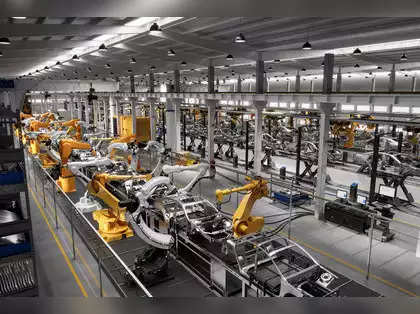
Digital twin technology, which creates virtual replicas of physical systems and processes, is rapidly emerging as a powerful sustainability tool for manufacturers. With climate change concerns intensifying, manufacturers across sectors are utilizing digital twins to optimize operations, boost efficiency, cut waste, and reduce their carbon footprint. Digital twins leverage real-time data from sensors and internet-connected devices to mirror real-world physical systems in a virtual format. Manufacturers can then continuously analyze digital twin data to gain valuable insights into streamlining production systems before actual implementation. This enables informed tweaking of processes to enhance output quality while minimizing energy expenditures and carbon emissions. Prominent Indian corporations across oil, gas, and renewable energy, pharmaceutical and mining sectors have already pioneered digital twin adoption. Cairn Oil & Gas deployed advanced platforms to enable remote facility control and uplift efficiency. With sustainability becoming intrinsic for survival, digital twins hold immense potential for manufacturers chasing green transformation.
Optimizing Manufacturing Processes – Digital twins empower manufacturers to simulate production processes and tackle potential glitches in the planning phase itself. Manufacturers can model various material combinations for minimal waste generation or energy requirements for green products. Optimized processes then translate into leaner manufacturing with a lower carbon footprint. For instance, simulation modeling enabled a leading manufacturer to reduce greenhouse emissions by 50%.
Asset Performance Management (APM) has become a primary enabler of digital transformation for asset management among industrial companies. By merging decades of machine modeling with modern cloud analytics, digital twins predict machinery availability, drill to the root cause of inefficient machine operation, and bring order to reliability and maintenance planning.
Predictive Maintenance: Unexpected equipment breakdowns during operations can lead to inefficiencies, production delays, and quality issues. Digital twins allow manufacturers to closely monitor machine performance and schedule predictive repairs before problems arise. This prevents revenue losses from downtime while enhancing asset lifespan and avoiding premature replacements – a key environmental plus! Organizations are nowadays using an outcome-based SaaS software and services predictive analytics to address asset health, integrity, cybersecurity, efficiency, and energy performance in one solution. This approach allows for standardized, faster and scalable deployment.
Energy Management – Manufacturing facilities like assembly lines consume vast energy to function. Digital twins grant holistic visibility into equipment and building energy loads. Armed with digital twin insights around peak usage trends and redundancy areas, manufacturers can develop targeted strategies for energy optimization and utility cost savings. Such digital opportunities can directly amplify energy efficiency, benefiting bottom lines alongside the environment.
Meeting Sustainability Compliance – Manufacturers need to adhere to evolving emissions regulations and environmental compliance policies. Digital twins allow the simulation of various operational scenarios to recognize sustainability bottlenecks. Manufacturers can then assess corrective measures to achieve compliance before actual implementation. This proactive approach protects manufacturers from potential regulatory violations that may attract legal penalties.
Process Control and System Testing: An up-to-date digital twin solutions are being used by manufacturers for tracking, managing, and testing process control changes and system modifications. This promotes safer engineering and services, brings the highest level of quality control to the smallest projects. Also, this is efficient, compliant, and collaborative solution to manage changes, factory acceptance tests, improved project execution and training.
Transitioning Towards Circular Economies – Digital twins are invaluable for simulating the incorporation of recycled materials into manufacturing applications without disrupting quality or productivity. Manufacturers can leverage digital models to test different ratios of recycled content across production processes. This accelerates optimization for reusing materials to reduce virgin resource consumption while mitigating disposal impacts – a leap towards the circular economy!
The Digital Twin ecosystem converges at the ‘Operations’ stage, unifying functionalities in an integrated manner to drive business outcomes. With increasing global environmental regulations and penalties for non-compliance, emissions monitoring, accounting, and reduction have become paramount. Sustainability Digital Twins monitor overall emissions through physical and soft sensors, assisting in tracking progress towards the organizational goal of ‘Net Zero’.
The Sustainability Digital Twin tracks greenhouse gas (GHG) emissions in real-time across the enterprise, enabling faster corrective actions. Through a fully automated data collection and validation process, coupled with near real-time GHG emissions calculation using a comprehensive emissions factor library, it provides a rich user experience, facilitating faster, better, and more accurate emissions reduction strategies to meet the organization’s decarbonization goals.
With a comprehensive Sustainability Digital Twin framework, HSE engineers can quickly visualize emissions input data from multiple disparate systems and centrally validate the calculated emissions footprint using robust calculations with the right emission factors. Simultaneously, the Chief Sustainability Officer (CSO) can validate the aggregated GHG emissions across the company and identify the site(s) impacting GHG emissions, recommending an action plan to meet environmental regulations and the commitment to the Carbon neutral goal.
As global sustainability consciousness grows, digital twins present the unmatched potential for manufacturers to embed green thinking into decision workflows. By enabling rapid virtual prototyping of systems, digital twins provide easily accessible yet powerful means for manufacturers to drive emission cuts and environment stewardship. The worldwide proliferation of this futuristic technology will undoubtedly accelerate as manufacturers realize its inherent value in reconciling the societal need for ecological sustainability with commercial growth ambitions!


